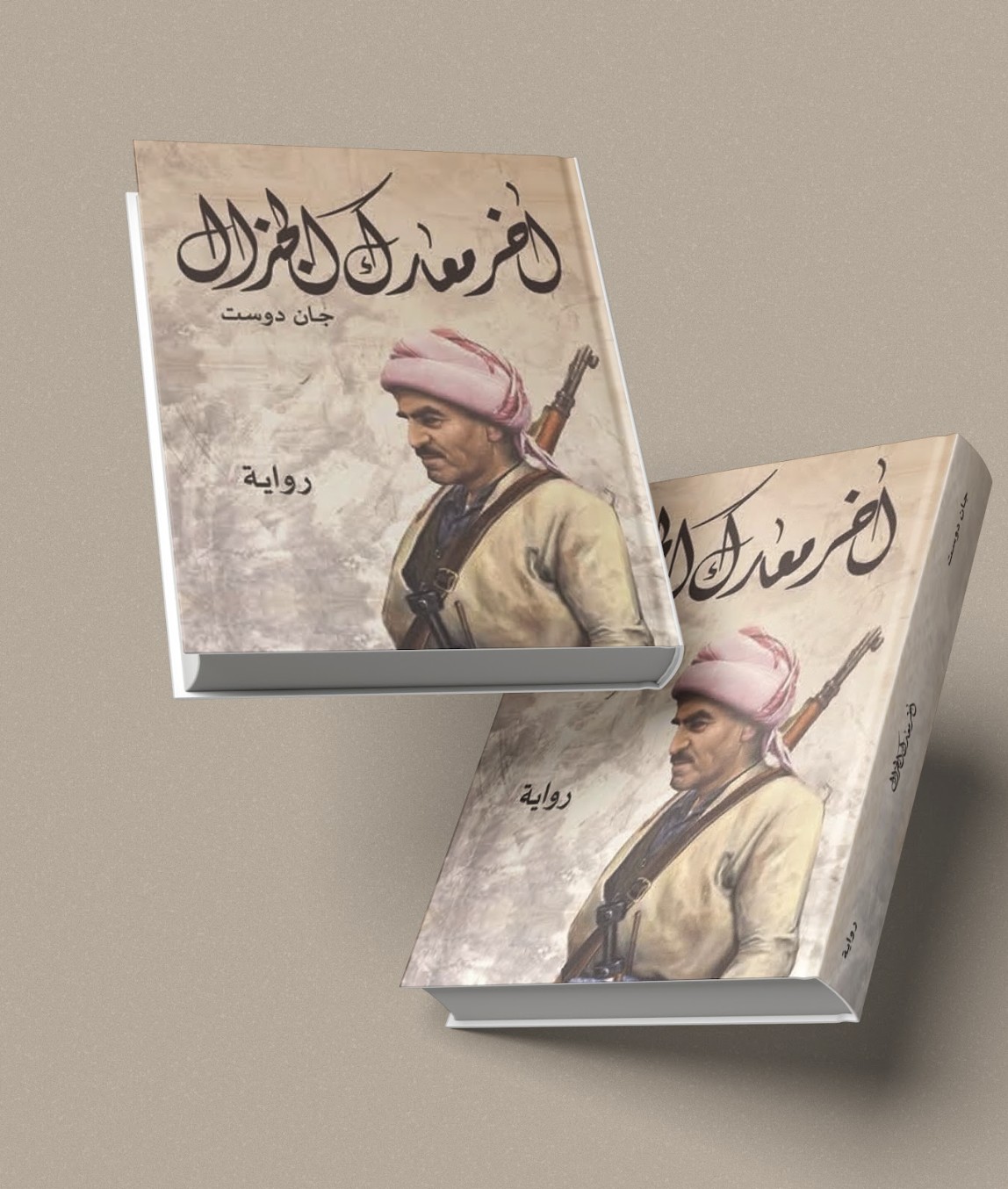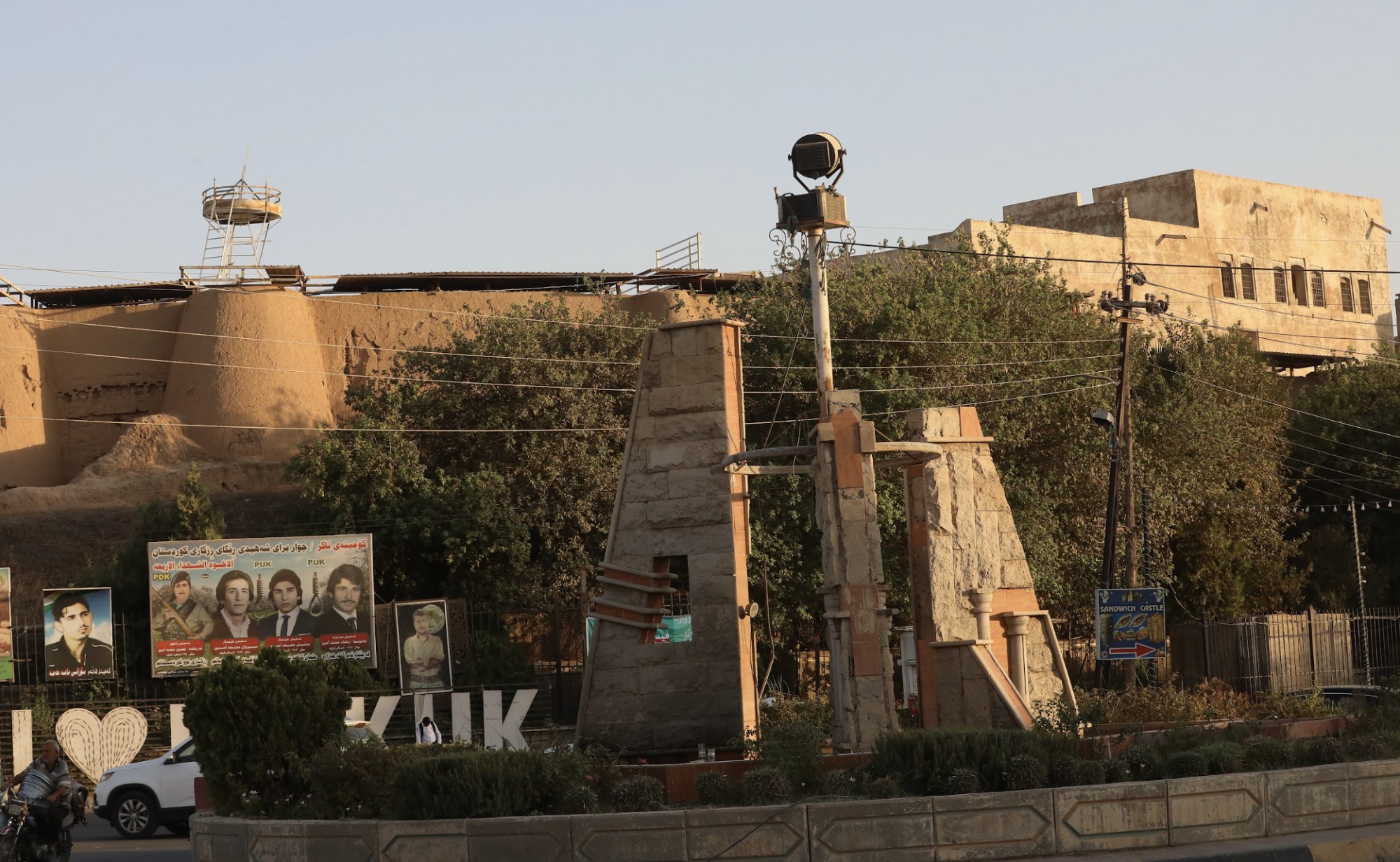December 23, 2023, was a frigid morning. Flurries of snow fell gently, dispelling the gloominess that hovered over Vienna. The thick, joyous blanket of snow extended along Lassallestraße where we were staying, hovering over the pristine landscape of the Danube River.
We started our morning with a precautionary Covid-19 test as we would meet with the Kurdish scholar Celêlê Celil. Born in 1936 in Yerevan, Celil has spent his life collecting Kurdish folklore, transcribing love songs and folk proverbs from the mouths of storytellers and singers, and studying the history of the 19th century Kurdish uprisings.
With our test results negative, we set off to Celil’s home in the town of Eichgraben, approximately 30 kilometers west of Vienna. My wife and I were accompanied by my friend Suleiman Mahmoud, director of the Kurdish Cultural Institute of Vienna.
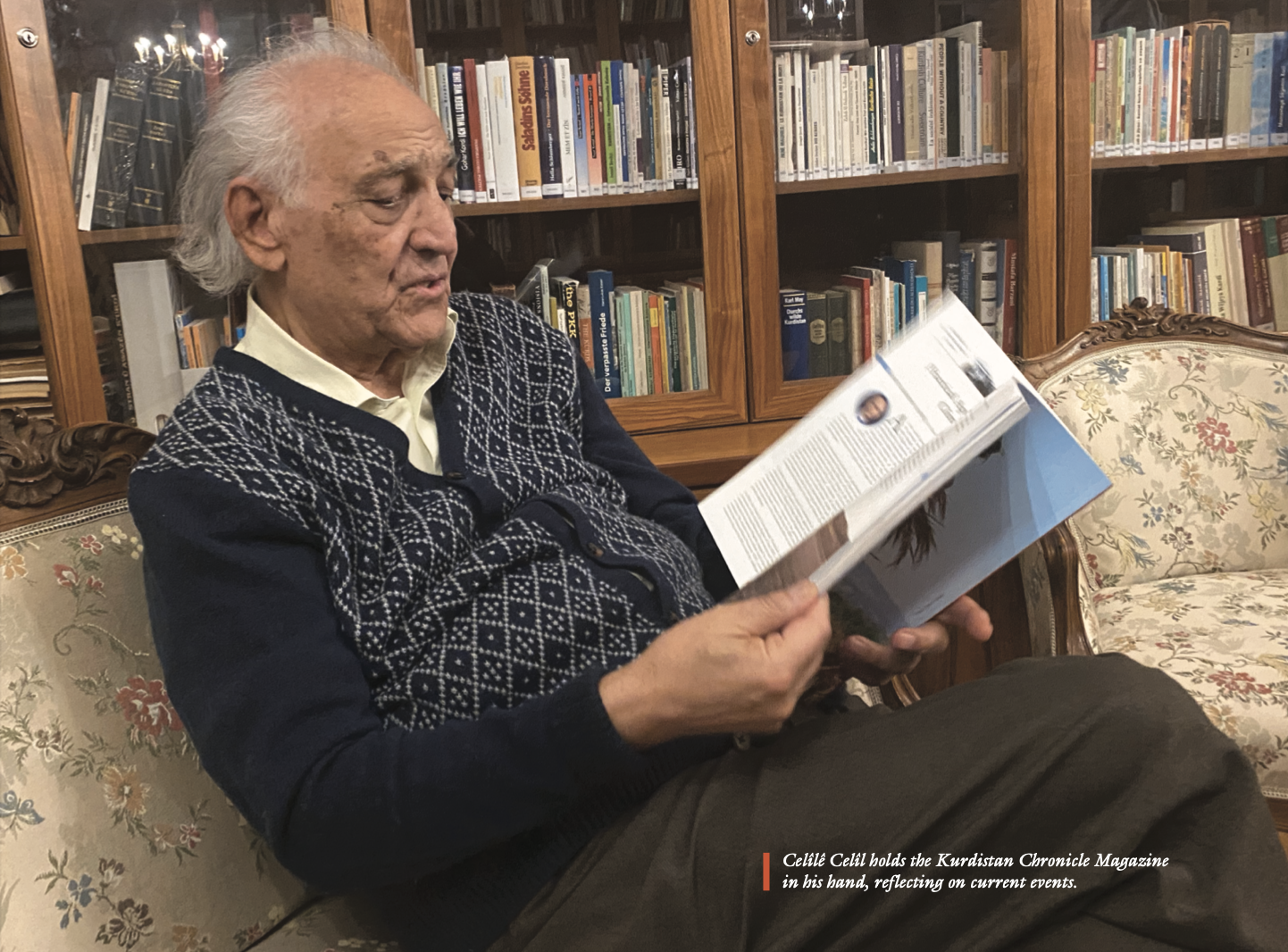
Recording the traditions of the past
Celil and his sister Zine, who works as a translator, greet us with a hearty welcome, as is customary among Armenian Kurds. Zine leads us into a large hall with shelves of books ornamenting the walls. Celil and I begin our conversation, and I dive right in with my first question:
“Who did you inherit your passion for books from?” I ask.
“My father, Casime Celil, was very interested in books,” he says. “Sometimes he would bring home ten copies of each book. I would ask him, ‘Why all these copies?’, to which he would reply that Kurdistan would need them in the future.”
“Where did your father inherit his love of books? From someone in his family?” I inquire.
“No. My father grew up in an orphanage in Armenia, and then studied electricity and worked at power stations in Yerevan. From 1928 to 1931, he worked and studied at the request of the Komsomol, a Soviet communist organization for youths aged 16 and older. Eventually he began collecting books and newspapers that talked about the Kurds. While in Yerevan, he heard about Isaak Maragulof, who was from the Syriac community and had apparently invented a Kurdish alphabet. He wrote to him, introducing himself and stating his wish to learn the Kurdish alphabet and to acquire books, to which Maragulof responded: ‘If there are Kurds around you, we will send you a large number of books.’ The Ministry of Culture had printed many propaganda brochures in Kurdish, and there were schools in Kurdish. When Kars was still under the Russians, Maragulof opened a Kurdish school in one of the villages where Assyrians and Kurds lived together. When power passed to the Soviets, he continued to teach Kurdish in Kurdish schools.
“Maragulof sent the books as promised, and now our house is filled with them.
“While working at Yerevan Polytechnic Institute, my father became responsible for the Kurdish printing press, which printed political propaganda, books on medicine, and school curricula, and it was my father’s habit to keep several copies of each. I brought three tons of books with me to Vienna, all in thirty or forty bags I bought from the market,” he explains.
“Are there any books left there?” I wonder.
“No. Who would I leave them to?” he replies. “At one point, Shifa Barzani, an official responsible for the Kurdistan community in Europe and the United States, visited me, and I shared with him that my father’s will had stipulated that I give a copy of each book to Kurdish institutions. I am now fulfilling his will.”
We begin to shift topics. “I transcribed many folk epics in Syria,” Celil says. “In Kobani, I reproduced a famous, heartfelt song from the mouth of the folk singer, Baqi Xido, called ‘Dilo’. Another called ‘Hami Muse’, which I transcribed in 1982 from the Qamishli singer Silo Koro, relates the uprising of some brave men from the Brazan Region of Kurdistan against forced conscription under the Ottomans. A second version came from an Armenian named Iskander who was singing in Kurdish in Shikhlar village in Armenia. Iskandar was quite knowledgeable about maqam singing yet his voice was not that sweet. The same song was also sung by Cimoye Tozo.”
“Sargis Haykouni also published it!” I exclaim.
“Yes, but I was unaware of his version,” Celil explains. “He didn't sing it. I only document singers because my job is to collect folklore. Haykouni had witnessed some traumatic events and felt deep pain because of it, which is why he demanded that they be collected. He argued that Armenians who knew Kurdish songs should document them because they’d also serve their cause.”
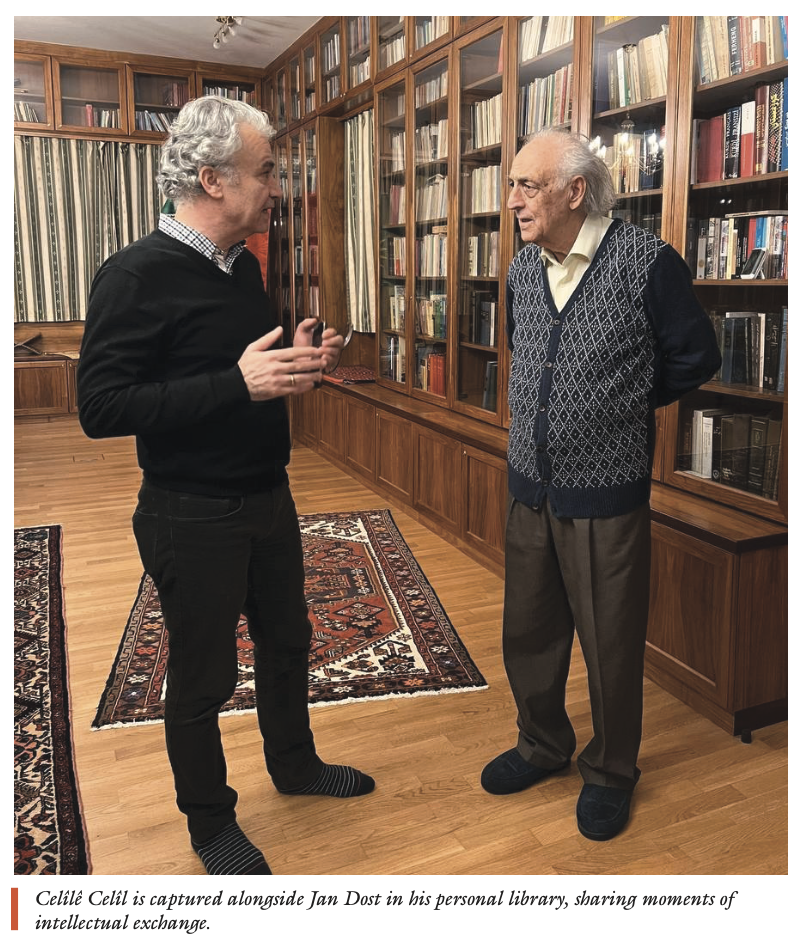
“What is the difference between Haykouni’s version and yours?” I ask.
“My copy is distinguished by the fact that I was the one who collected it, deciphering it soon after my brother Ordixan died seventeen years ago,” he says.
Celil pauses for a moment to read from Sexishtik poems composed by Kurds from Khorasan. Sexishtik is a short Kurdish poetry form consisting of three lines with one rhyme. It resembles the Japanese haiku and is characteristic of the Khorasan Kurds.
“Which Kurdish region is richest in folklore?” I inquire.
“Every place in Kurdistan has preserved the ancient traditions,” he says. “Every Kurdish individual has a connection to folk heritage. I once traveled to Qamishli, where a Communist Party official received me and invited me to a public gathering. I told him that I would attend on the condition that folklore be the focus of our conversation. We then sat on chairs in a circle in a beautiful garden. I asked the people sitting to each recite something from folklore. Some at first protested and said, ‘How on earth are we supposed to know about folklore?’ to which I replied: ‘Let the first of you say an old saying, then the next one follow, and continue in this way.’ This worked, and beautiful Kurdish proverbs and sayings started to pour out.”
“Our family, my sister Cemila, Ordixan and I, received an invitation from the Kurdistan Regional Government (KRG) Minister of Culture, Falak al-Din Kakai,” Celil relates. “I didn’t want to go at first. I was pessimistic that we, the three siblings, would travel and something terrible happen while we were on the same airplane. I sent my sister and brother. The KRG took a great care of them. They also received special care from the Barzanis, and Cemila and Ordixan returned very impressed by the care and hospitality they received.”
The professor continues to talk excitedly, but I take advantage of a moment of silence to present him the latest copy of Kurdistan Chronicle. He has already received the previous ten issues.
“This magazine is really necessary,” he says. “It represents us in the best way possible. Other cultures must get to know more about our culture, realities, societies, and customs. They only know that we are freedom fighters. We are the kind of people who hardly ever agree among ourselves. But there are other beautiful things they should know about us.”
When I asked him about his brother Ordixan, the researcher, Celil asks his nephew to bring his brother’s book of Kurdish historical songs, along with their Russian translations.
As he peruses the pages, he says: “Many of the songs that my brother documented were performed by Armenian folk singers. Songs about the Sheikh Said rebellion, the Ararat uprising, and many others had not reached us. He told me to take these songs to several places to compare them. Once, he journeyed to an Armenian village to visit the house of a singer, Ise Varte – his name is Israel and Vart is his mother’s. Knowing that Ise’s mother had passed away one week earlier, he apologized but nevertheless inquired into whether he would sing. Ise replied: ‘Son! You went through all the trouble traveling from Leningrad to Yerevan and you came all this way and now you are my guest. How can you go back empty-handed?’
“He then proceeded to sing many sad, melodious epics that lauded the exploits of the brave. So we have benefited greatly from the Armenians, some of whom have served our culture and preserved a great deal of our folk heritage.”
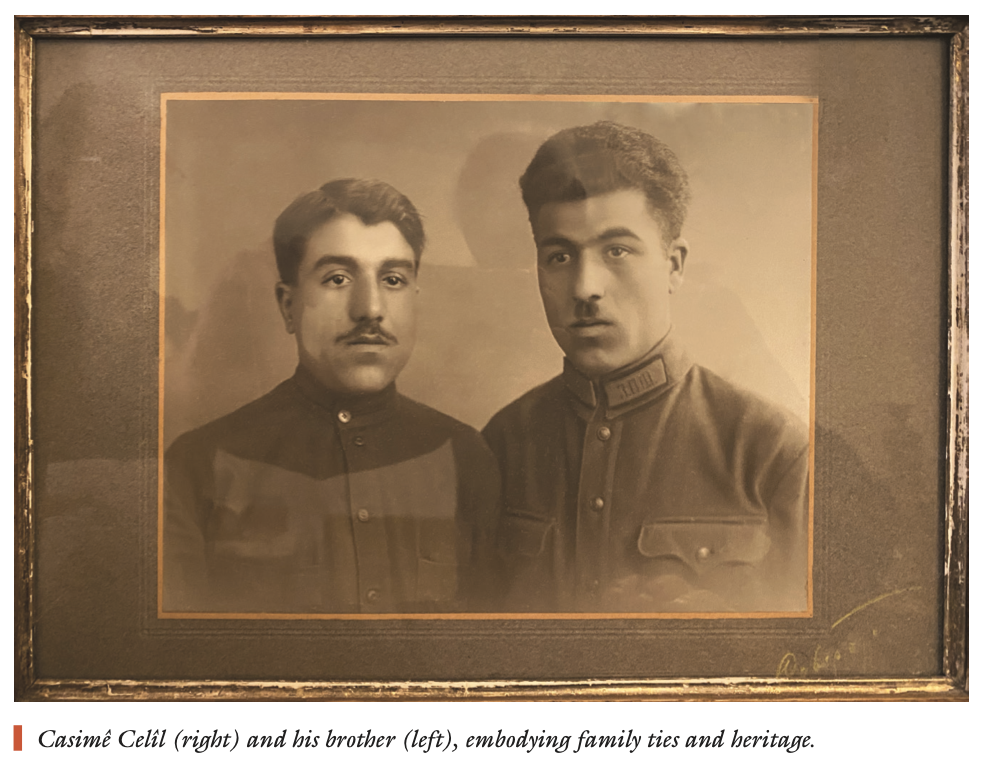
Encountering Barzani
Shifting gears, we inquire about Celil’s encounters with Mulla Mustafa Barzani, with whom Celil met during the Kurdish leader’s long stay in the Soviet Union.
“Yes. I met him twice. Once he came to Yerevan, which was famous among the Kurds thanks to the Kurdish radio. Moscow and the Soviet government cared greatly about the Kurds of Armenia. Barzani arrived there for a brief visit just after the overthrow of Iraqi Prime Minister Nuri al-Said. He was an official guest of the state, and it was not easy to meet him. He was accompanied by Nado Mahmudov, a government official of Kurdish origin, as well as Siyaband Siyabandov, a hero of the Soviet Union who held a high position in the Communist Party of Armenia.
Barzani’s freedom to meet with people was limited, but he wanted to visit a village. The local authorities had no choice but to rush to install some nice furniture in a few homes. Barzani, aware of these political games, suggested that he visit a house randomly, where he discovered the true poverty of the people.
“My father met Barzani at the radio, and I was keen to meet him as well. At the time, I was in my last year of university. My father suggested I call my ‘Uncle’ Nado – not my real uncle, but the moniker is a sign of respect – and convey my interest. Uncle Nado loved me and, though there was very little time, he told me to come to the airport early the next morning. I did just that and found Barzani there with a small entourage. Excitedly, I told him, ‘We, the young people here, are ready to join the revolution and fight.’ He replied: ‘Son! We need you dearly. But not for fighting. I have many fighters. We will need you after we liberate our homeland. You will come to us then.’”
“What about the second time you saw him?” I ask.
“The second time I saw him, in Tashkent, he had the same charisma. Professor Qanate Kurdo was in the Uzbek capital as a delegate of the University in Leningrad and head of the Department of Kurdish Studies and through him I met Barzani again. During their conversation, the epic of Dimdim Castle was discussed, and Kurdo mentioned that my brother Ordixan was working on this epic. Barzani said that among his fighters were those who knew and sang this epic.
“When Kurdo returned to Leningrad, he told Ordixan the story about what happened between him and Barzani. Ordîxan asked how to reach these singers among his fighters, and Kurdo gave him his phone number in Moscow. In the summer of 1958, I was in Leningrad with Ordixan to learn about Soviet historical landmarks. Meanwhile, my mother rendezvoused with us in Moscow. The three of us called Barzani from a phone booth, told him the purpose of our visit, and related my mother’s wish to meet him. He accepted.
“Unfortunately, the international female students at our accommodation had seen our mother alone and taken her out to explore with them. So, we went to meet Barzani without her. The leader gave us a map of Kurdistan that was hanging on the wall in his room.”

Sheikh Ubeydullah Al-Nahri’s revolution and Jilal’s doctoral dissertation
As noted earlier, Celêlê Celil had an interested in the Kurdish uprisings in the 19th century. His studies are significant in their own right; he has extensive knowledge of the primary sources that explain the disappearance of the local Kurdish emirates during this period. Celil’s academic devotion manifested in his doctoral dissertation on the revolution of Sheikh Ubeydullahal-Nahri, which is considered the first uprising after the collapse of the Kurdish emirates, the result of the power vacuum that Kurdish regions witnessed after the Russo-Turkish War of 1877-1878.
I ask Celil more about his academic research for the dissertation.
“I collected literary materials in several languages related to that period,” he says. “But I needed to read the archival record in Moscow of Russian consulates and embassies. There, I found the documents and correspondence of those diplomatic bodies from Khoy, Salmas, Erzurum, and Istanbul, as well as the consular correspondence between them about events along the common border. These records enabled me to write about the uprising of Sheikh UbeydullahAl-Nahri.”
“You published a book entitled Why is the Camel Angry?, which I read an Arabic translation of. What is the book about?” I ask.
“This book contains thirteen texts on folklore, including a letter to my father, a letter from August Jaba, a mid-19th century Russian consul in Erzurum, and other documents. My sister Zine translated this book into Russian,” he says.
A painting representing Mustafa Barzani catches my eye, so I ask him about it.
“It was drawn by a colleague of mine at the university in 1957. He had copied it from a magazine. At that time, the Soviet press was publishing many reports and articles about Barzani. This is a map of Kurdistan from the American archives [looking at two maps on the wall]. This other map is from the Russian archive and shows the geographical distribution of the Kurdish population.”
As the conversation winds down after three hours, which included the shooting of videos, the taking of photos, and the drinking of tea, we move to leave, but Celil asks us to stay. “By doing so, you are adding a lifetime to my life,” he smiles.
As we bid farewell at the door, we know that we had spent time with someone who was a witness to a volatile and rich period of history, a faithful guardian of Kurdish folklore. He waves until our car, driven by his nephew, disappears into the darkness of the street.
Jan Dost is a prolific Kurdish poet, writer and translator. He has published several novels and translated a number of literary Kurdish masterpieces into Arabic.
